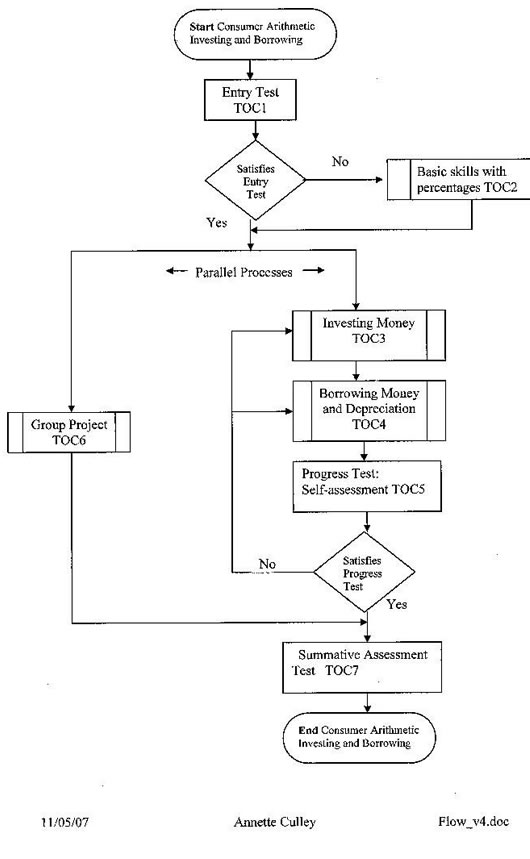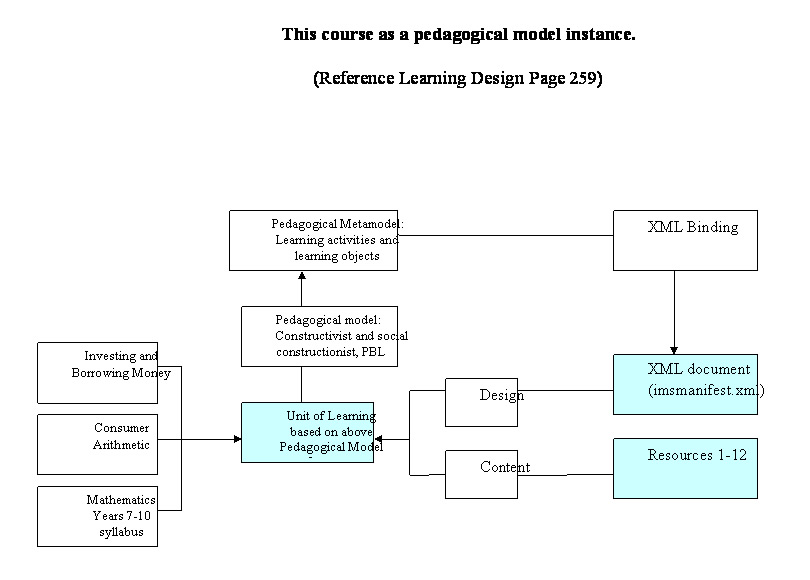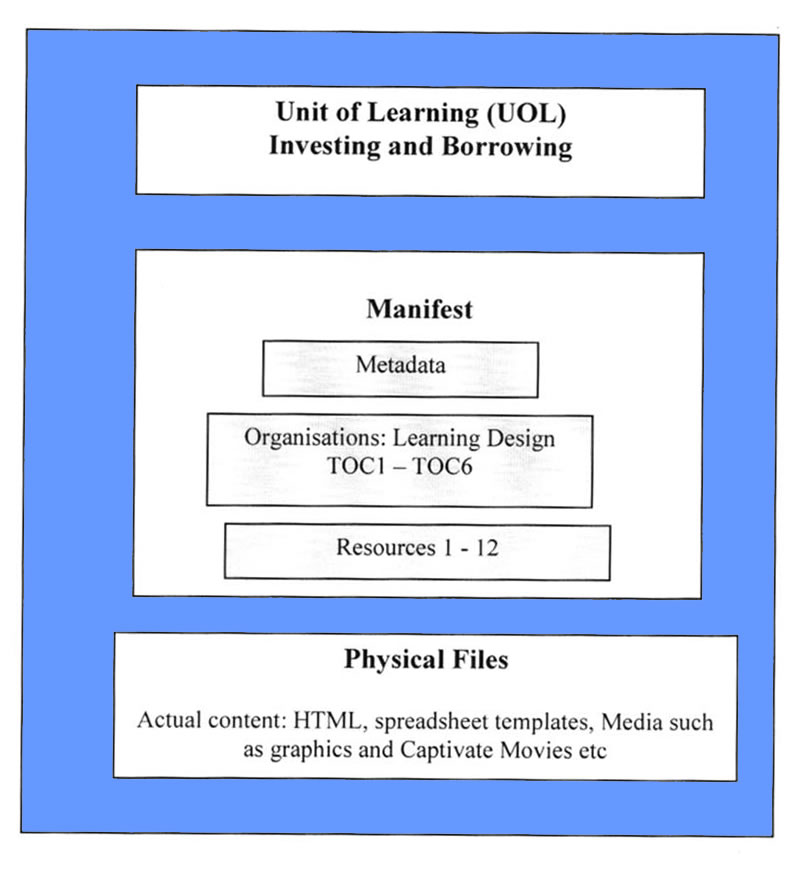Designing a Moodle Module
Written by Annette Devilee – prepared as part of the assessment for her Master of Learning Science and Technology (MLS&T) at The University of Sydney. 2008.

Introduction and Pedagogical Framework
Investing and Borrowing Money, Moodle Project
Completed as a requriement of the Masters of Learning Science and Technology course at the University of Sydney, 2007.
In February 2007 I approached the Centre for Learning Innovation to discuss an authentic project for this masters unit. They suggested that I work on Financial Mathematics because this was a unit they needed but lacked the resources to create the course. I chose to focus my project on Investing and Borrowing which addresses the NSW Mathematics Years 7-10 Syllabus, Stage 5, Consumer Arithmetic: Solves consumer arithmetic problems involving simple interest, compound interest and depreciation.
The course is designed as an online resource for distance education. It is designed for implementation from within the Moodle e-learning environment. Moodle’s features such as Forums, Blogs, Wikis and Chat facilitate a pedagogical approach based on constructivist and social constructionist learning theories.
The instructional style adopted by this is in line with the following recommendations (Everybody Counts, cited in Schoenfeld, 1992. p. 4):
- Seeking solutions, not just memorizing procedures;
- Exploring patterns, not just memorizing formulas;
- Formulating conjectures, not just doing exercises.
Consequently this course is styled on the conception that
“a degree of control over their own learning can provide challenge, motivation and engagement for a wide range of student groups.” (Hennessy et al, 2007. p.140)
This course provides opportunities for students to exploit the interactive affordances offered by the Moodle platform. Students are encouraged to explore, participate or manipulate various tools to become actively involved in the construction of individual and collaborative artifacts. This includes self assessment by means of quizzes and peer tutoring for remediation. Wikis are used for collaborative writing for the construction of knowledge. Discussion Forums are used for asynchronous discussion and collaboration. Chat rooms are used for synchronous lessons or discussions. Blogs are used for individual reflection. Emails are used for sending scanned handwritten work done by the student and general asynchronous communication.
In addition to the ICT resources afforded by Moodle, this course on Consumer Arithmetic utilizes Spreadsheets as Mindtools to engage learners in critical thinking. The use of spreadsheets as a dynamic modeling tool enables the student to free themselves from the tedious and time consuming task of multiple calculations required for compound interest so that they can concentrate on higher order thinking: analysis, evaluation, synthesis, elaboration, decision making, designing solutions and solving complex problems. The spreadsheet allows the student to pose “What if?” questions, to make hypothesis and to test their ideas.
Worked examples and assignments provide a skill base and resource for the students within a Problem Based Learning (PBL) framework.
“Mathematics instruction should provide students the opportunity to explore a broad range of problems and problem situations, ranging from exercises to open-ended problems and exploratory situations.” (Schoenfeld, 1992. p. 32)
Slavery and Duffy (1995) suggested the following principles for PBL which guide the delivery of this course:
- Anchor all learning activities to a larger task or problem.
- Support the learner in developing ownership for the overall problem or task
- Design an authentic task.
- Design the task and the learning environment to reflect the complexity of the environment they should be able to function in at the end of learning.
- Give the learner ownership of the process used to develop a solution.
- Design the learning environment to support and challenge the learner’s thinking.
- Encourage testing ideas against alternative views and alternative contexts
- Provide opportunity for and support reflection on both the content learned and the learning process.
The framing problem for this unit provides an “open inquiry learning environment; solving problems in ill-defined contexts, and cooperative learning” (Lewis et al., 1998). The act of posing problems is integral to the process of solving problems.
“Finding or posing problems is a quintessentially creative endeavor. Whether the found problem is the presence of a hole in the ozone, or that people who smoke are prone to cancer, those keen enough to call our attention to them distinguish themselves by their astuteness. They help set community agendas that lead to discoveries and invention that help make the world better.” (Lewis et al., 1998)
The posing of problems can occur prior to, during, or after the act of problem solving. By keeping the problem open, the students in this course can “frame and reframe” their perspective on a problem so they reach “goal clarity”. Educational psychologists have discovered that solving a problem is a back-and-forth (recursive) process, not a linear one (Pea, 1985). In this way the student is able to take ownership of the problem and see it as their own problem thus enhancing motivation, responsibility and learning.
This course approaches mathematics education through solving environmental economics problems at a personal and social level. Although a framing problem is provided to the student, the student groups actually need to pose the specific perspective they will take to the problem. The students become the designer and active creator of a collaborative knowledge building process.
The Design Process
Investing and Borrowing Money, Moodle Project
I have kept a record of the design process in my Blog in Moodle at
http://moodle.edfac.usyd.edu.au/blog/index.php?userid=7&courseid=7
I used a tailor-made approach to this course design which allowed the design to evolve over a number of iterative cycles. First the Instructional Strategy table was produced. Secondly the learning design was represented by three levels of flowcharts. From this the XML binding was tested in Moodle. The use of Data Flow Diagrams and a Context Diagram were very good for identifying the Media resources that were to be used in the Moodle Environment. Finally the detailed lesson-by-lesson and Task description provides the final document to be ready to start the Development phase of the project.
| Client Consultation- Course Description | |
| Syllabus- Identify unit, Course Scope determined | |
 |
1. Instructional Strategy – table based on syllabus objectives and outcomes. Beginning to identify the various media I will use and the division/sub topics of the course. |
| Research/Reading about Problem based learning- ongoing | |
 |
2. Flowcharts with 3 levels of modules- this process organises the order in which the course will proceed and identify the critical instructional assets. My flowcharts included the names of the SCORM organisations and Items |
| Design and test the SCORM Package to match flowchart: imsmanifest.xml and html templates for resources are uploaded into the Moodle LMP | |
 |
3. Context Diagram and two Data Flow diagrams– this was very useful to see the way information flowed between students and teacher, the processes and the data stores. |
| Course Requirements/Assessment Document | |
 |
4. Detailed lesson-by-lesson and Task description– will assist in the content of the web resources within the course. |
| Review this meets the syllabus requirements- The syllabus requirements are to be placed within the web pages (SCORM Items) | |
| Client consultation- to make sure this design is suitable before the development phase begins | |
| Finalise Documentation
(10-12 HOURS PER WEEK, 7 WEEKS = 70 -80 HOURS) |
The Flowchart

The Learning Design
nvesting and Borrowing Money, Moodle Project

Context Diagram
Investing and Borrowing Money, Moodle Project


The Teachers’Role
Investing and Borrowing Money, Moodle Project
Teaching actions for problem solving (Adapted from Lester, Garofalo, & Kroll, 1989, P. 26)
Teaching Action Purpose
BEFORE
- Read the problem… Discuss words or illustrate the importance of reading phrases students may not understand carefully; focus on special vocabulary
- Use whole-class discussion to focus on Focus on important data, clarification importance of understanding the problem process
- (Optional) Whole-class discussion of Elicit ideas for possible ways to solve possible strategies to solve a problem the problem
DURING
- Observe and question students to Diagnose strengths and weaknesses determine where they are.
- Provide hints as needed Help students past blockages.
- Provide problem extensions as needed Challenge early finishers to generalize.
- Require students who obtain a solution Require students to look over their work to “answer the question” and make sure it makes sense.
AFTER
- Show and discuss solutions Show and name different strategies
- Relate to previously solved problems Demonstrate general applicability of or have students solve extensions problem solving strategies
- Discuss special features, e.g. pictures Show how features may influence approach
Its classroom recommendations were that the teacher:
- Model problem-solving behavior whenever possible, exploring and experimenting along with students.
- Create a classroom atmosphere in which all students feel comfortable trying out ideas.
- Invite students to explain their thinking at all stages of problem solving.
- Allow for the fact that more than one strategy may be needed to solve a given problem and that problems may require original approaches.
- Present problem situations that closely resemble real situations in their richness and complexity so that the experience that students gain in the classroom will be transferable.
(California State Department of education, 1985, p. 14.)
